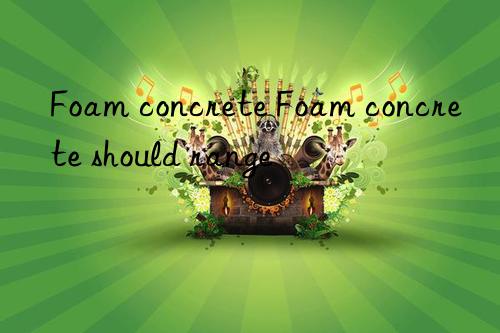
(1) Used as a retaining wall. Mainly used as a rock wall for the harbor. Used as lightweight backfill material behind the quay wall to reduce vertical intercept loads and also reduce lateral loads on the quay wall. This is because it is a rigid body with good bonding performance. It does not exert lateral pressure on the quay wall along the periphery. The settlement is reduced, and the maintenance costs are reduced accordingly, thus saving a lot of expenses. Bubble concrete can also be used to improve the stability of embankment slopes by replacing part of the soil on the slope. By reducing the mass, the forces affecting the slope stability are reduced.
(2) Build sports fields and track and field tracks. Use permeable foam concrete with strong drainage capabilities as a lightweight foundation, covered with gravel or artificial turf for a sports field. The density of bubble concrete is 800~900kg/m3. This kind of sports field can be used for hockey, football and tennis activities. Or a layer of 0.05m thick porous asphalt layer and plastic layer can be covered on the bubble concrete, which can be used as a track and field track.
(3) As a sandwich component. Cellular concrete can be used as the inner core in prefabricated reinforced concrete components, giving it good performance in lightweight, high-strength thermal insulation. Foam concrete with a density of 400~600kg/m3 is usually used.
(4) Pipeline backfilling. Abandoned underground oil tanks, pipelines (containing crude oil and chemicals), sewage pipes and other cavities can easily lead to fires or collapses. Using bubble concrete backfill can solve these problems at a low cost. The density used in bubble concrete depends on the diameter of the pipe and the groundwater level, generally 600~1100kg/m3.
(5) Lean concrete filling layer. Due to the use of flexible hoses, bubble concrete has great workability and adaptability, so it is often used for lean concrete fill. If the requirements for thermal insulation are not very high, use a lean concrete filling layer with a density of about 1200kg/m3 and an average thickness of 0.05m; if the requirements for thermal insulation are very high, use a lean concrete filling layer with a density of 500kg/m3 , the average thickness is 0.1~0.2m.
(6) Roof slope. Bubble concrete is used for roof slopes and has the advantages of light weight, fast construction speed, and low price. The slope is generally 10mm/m, the thickness is 0.03~0.2m, and the density of bubble concrete is 800~1200kg/m3.
(7) Support of tank feet. Pour foam concrete steps at the bottom of the foot of the steel storage tank (containing crude oil and chemicals). If necessary, a convex foundation can be formed. This can ensure that the support of the entire tank bottom is in the best stress state during welding. A continuous support allows the tank to have a sheet bottom. The convex foundation is also easy to clean. The usage density of bubble concrete is 800-1000kg/m3.
(8) Used for landscaping. The foam concrete is made with a bulk density of 600-1000kg/m3 and can be used for garden rockeries, trash cans, tables and stools, etc.
(9) National defense (modern warfare uses information and advanced mobile equipment as attack tools), this bubble concrete can be used in military projects such as airports, important transportation highways, etc. that have been damaged by enemy bombing for immediate emergency repair. Use us The equipment and technology can quickly repair the projects destroyed by the enemy. The result of the experiment is that it can be used for aircraft takeoff and landing and combat vehicles to pass within 10 minutes after repair.
(10) Application on highways
1) Reduce load or soil pressure
① Subgrade replacement on the back of newly built highway bridge abutment: effectively solve the engineering settlement left by insufficient preloading of soft foundation sections Problem;
② Replacement of roadbed behind the abutment of old road reconstruction: can completely solve the bridge head jumping problem caused by post-construction settlement at one time;
③Widden roadbed filling in road expansion: better Solve the problem of differential deformation of old and new roadbeds, and save land acquisition and avoid demolition;
④ Roadbed filling in steep mountainous sections: avoid construction technical difficulties caused by high filling and high excavation;
⑤Used for large underground spans Covering load relief in structural engineering.
2) Self-leveling properties
①Filling in small spaces;
②Goaf areas, lava areas, building foundation pits, cavities formed by tunnel collapse and gaps around underground pipelines. </p

 微信扫一扫打赏
微信扫一扫打赏

